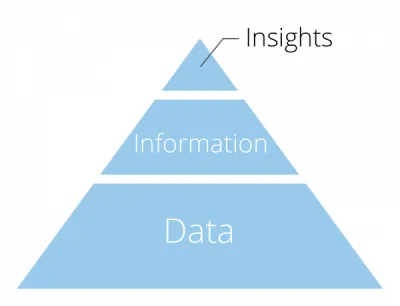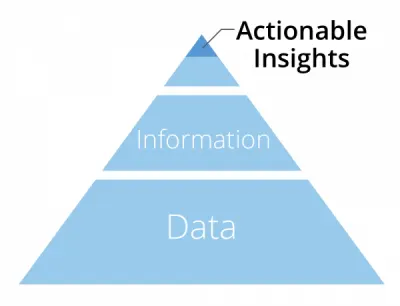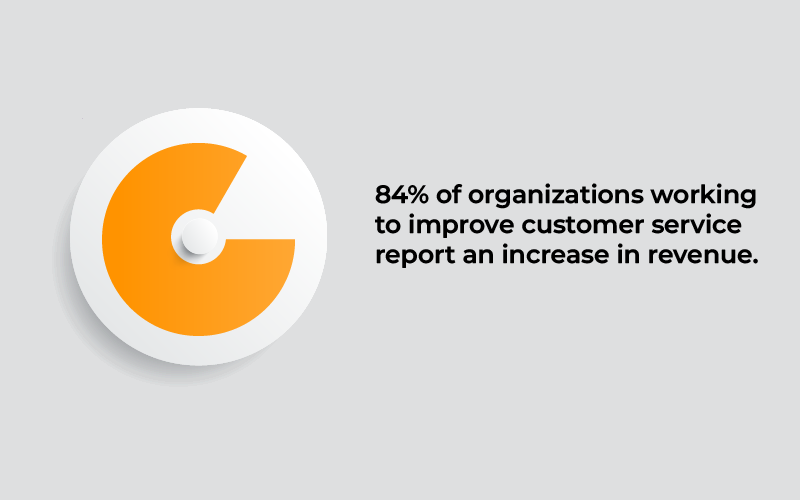It is of the utmost importance for businesses seeking growth to keep an eye on what their customers want. The simplest way to do it is to comprehend and build upon the feedback they offer about your goods and services.
They indicate how successfully you meet the wants and expectations of your customers and how likely they are to do business with you again and refer you to others. You must analyze the data they have gathered in order to uncover relevant results and to turn your customer feedback into actionable insights, often referred to as actionable insights.
Actionable Customer Insights- Definition
Actionable insights are specific pieces of information or knowledge that can be directly applied to make informed decisions, drive improvements, and achieve meaningful outcomes. These insights are derived from data analysis, observation, or research and are characterized by their potential to guide actions that lead to tangible and positive results.
All of the terms “data,” “information,” “insights,” and “actionable insights” are extremely bound to one another.
-Data is the unprocessed, uncooked facts that are typically presented as numbers and text. -Data that has been processed, compiled, and organized into a more readable format with additional context is called information.
-The process of analyzing data and coming to conclusions gives insights.
Finding insights that can then affect decisions and spur change is enabled by both data and information.

Actionable (Action-oriented) insights are more valuable than generic ones since they motivate behavior and decision-making. They force you to reconsider and steer you in a different direction. They are the treasured result of the tedious tasks involved in gathering, processing, and analyzing your data.

In the context of customer feedback, actionable insights refer to the conclusions drawn from analyzing customer opinions, behaviors, and preferences. These insights are actionable because they provide guidance on what steps an organization should take to enhance its products, services, or processes in ways that directly address customer needs and concerns.
Why do actionable customer insights matter?
All businesses today want to focus on data. Forrester reports that 74% of firms say they want to be “data-driven,” but only 29% are actually successful at connecting analytics to action. But making that one first move is important.
Actionable insights essentially fill the gap between ineffective decision-making and raw data. Based on facts from the actual world, they enable organizations to make decisions that promote good change.
Simply stating that you are a “customer-first” company won’t cut it. In order to truly understand what is going through a customer’s mind, it is crucial to dive deeply into consumer insights. Greater customer service and possible revenue growth can be achieved by having a deeper grasp of customer psychology, behavior, and preference. You can easily address their issues before they cause too much dissatisfaction. And that can be done if you identify the root of their issues through recent, honest feedback.
The Value of Customer Feedback
Customer feedback is a powerful tool that guides businesses toward growth, innovation, and customer satisfaction. By actively seeking and responding to feedback, businesses can foster strong relationships with customers and stay ahead in a competitive market.
Customer feedback holds significant importance for businesses across various industries. Here are several reasons why customer feedback is crucial:
1 . Insight into Customer Preferences and Needs:
Customer feedback provides valuable insights into what customers like, dislike, and expect from your products or services. This information helps you align your offerings with customer preferences and improve your offerings accordingly.
2 . Product Improvement:
Feedback highlights areas that need improvement. Identifying and addressing shortcomings can lead to enhanced product quality and better customer experiences, ultimately boosting customer satisfaction and loyalty.
3 . Innovation and Creativity:
Customer feedback can spark innovative ideas for new products, features, or services. Listening to customer suggestions can drive your business to develop solutions that better meet their evolving needs.
4 . Enhanced Customer Satisfaction:
By addressing customer concerns and suggestions, you show that you value their opinions and are committed to their satisfaction. This can foster strong customer relationships and build trust.
5. Competitive Advantage:
Utilizing customer feedback to make continuous improvements gives you a competitive edge. Businesses that actively seek and implement customer suggestions are more likely to stand out in the market.
6. Reduced Churn:
Negative feedback often highlights issues that lead to customer churn. Addressing these concerns can help retain customers who might otherwise switch to a competitor.
7. Brand Loyalty:
Customers appreciate businesses that actively seek their opinions. This engagement can foster a sense of loyalty, as customers feel like they’re part of the brand’s development process.Referrals:Satisfied customers are more likely to recommend your business to others. By acting on their feedback, you create a positive image that encourages word-of-mouth marketing.
8. Data-Driven Decision Making:
Customer feedback provides concrete data that can guide your business decisions. It allows you to make informed choices based on real-world insights rather than assumptions.
9. Measuring CSAT:
Feedback helps measure customer satisfaction and identify areas where you excel or fall short. This data is essential for setting benchmarks and tracking improvements over time.
10. Long-Term Growth:
Incorporating customer feedback into your business strategy contributes to long-term growth and sustainability. It helps you adapt to changing market dynamics and evolving customer expectations.
A step-by-step guide to turning customer feedback into actionable insights

84% of companies that work to improve their customer experience report an increase in their revenue.
Given the large number of businesses reporting revenue growth, it is important for businesses to find strategies to transform customer feedback into useful insights because it directly affects customer satisfaction. Here are the best ways to refine unprocessed information into actionable insights:
1 . Gather feedback:
Collect structured feedback through surveys and unstructured data from review sites, social media, and call center interactions. Diverse sources provide a full picture. Having a proper tool for collecting and analyzing feedback goes a long way. Kapture’s Feedback Pro is designed to capture the essence of feedback at each stage of the customer experience in order to acquire more insights across all customer touchpoints.
2. Categorize and Organize:
Sort feedback into groups based on common themes or subjects. Categorizing raw feedback data into several categories helps in understanding and gaining a visual image of what your consumers have to say about you. This structure makes it easy to discover patterns and prioritize areas for development.
3. Analyze Trends:
Quantify feedback if feasible by tracking the frequency of mentions or the mood associated with various themes. This gives your research a data-driven dimension. Within the feedback, look for recurring concerns, suggestions, and patterns. Determine the most commonly cited areas of pain or appreciation.
4. Competitor review analysis:
Another excellent strategy for companies seeking actionable insights is to examine what customers are saying about their competition. This will help you in understanding what your customers enjoy and dislike about a product or service. Following that, you can make proactive efforts to improve your product or service.
5. Test and Validate:
Consider possible fixes to the defined problems. Also, collaborate with your team to develop innovative and successful improvement ideas.
It is always a good idea to test solutions on a smaller scale or obtain further input on planned modifications before implementing large-scale changes. This contributes to the effectiveness of your solutions.
6. Implement Changes:
Implement the necessary changes to fix the identified issues based on your analysis and testing. This could include adjustments to products, process enhancements, or customer interactions.
7. Monitor Results:
Keep track of how your changes affect customer feedback, satisfaction, and other key metrics. Continuously monitor to verify if the solutions implemented are having the desired effect.
Benefits of turning customer feedback into actionable insights
When customers’ feedback is considered, they feel valued and cared for. Gen Z stats show that young people are even more impressed when you take their thoughts into account. 77% of them praise brands that are responsive on social media and many follow their favorite brands there. 55% of them believe most brands take feedback into consideration, as opposed to 49% of the general respondents.
Talking about the benefits of turning customer feedback into actionable insights, there are numerous. Some of the major benefits are:
1 . Increased Customer Satisfaction:
Customers’ satisfaction automatically rises once they realize they are being taken care of. Responding to complaints and ideas directly raises customer satisfaction. When customers’ suggestions are implemented, they feel valued and understood.
2 . Prevent customer churn:

Customer satisfaction is directly correlated with customer churn rate. The turnover rate will be lower the more satisfied your clients are with you. Your dedication to satisfying customer demands is demonstrated by your active participation in feedback. This generates long-term connections, recurring business, and loyalty.
3 . Informed decision making:
Actionable insights derived from feedback provide valuable data for making informed business decisions. This data-driven approach reduces guesswork and minimizes risks associated with blind decision-making.
4. Higher Quality of Products & Services:
Feedback-driven improvements result in higher-quality offerings. Addressing pain points and enhancing features based on feedback leads to products and services that better meet customer needs.
5. Optimized Customer Experience:
When customers provide their feedback regarding the products they use, the services they avail of, and everything about their experience in general and businesses work on it in that direction, that is what helps optimize their experience. Optimized CX helps to achieve a positive customer experience and a better satisfaction score.
6. Increased Revenue:
Customers who are satisfied are more inclined to repurchase products and spend more money. more average transaction values and more revenue can result from improved customer experiences.
Wrap-up
It takes intentional effort to continuously turn your customer feedback into actionable insights. However, there is a huge payback in the form of decreased churn, elevated loyalty, brand distinction, and eventually improved revenue. Customer feedback has the potential to become one of your most important resources with the appropriate plan and dedication to action.
Talk to our product squad: schedule a demo today!
,
,
,
,
,
,
,
,
,
,
,
,
,








